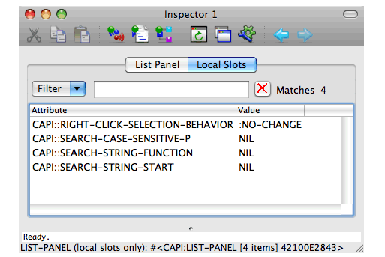 to remove the filter
to remove the filter





The attributes and values list is the most interesting part of the Inspector. Each item in this list describes an attribute of the inspected object by displaying its name (the first field in each entry) and the printed representation of its value (the second field). For example, the inspection of a CLOS object yields a list of its slots and their values. The description is called an inspection .
When inspecting instances of CLOS classes, you can choose to display only those slots which are local to the class. By default, all slots are displayed, including those inherited from superclasses of the class of the inspected object.
Several slots defined locally for a
list-panel
are listed.
Figure 17.4 Inspector showing local slots of a CLOS instance


As well as CLOS instances, other objects including lists and hashtables have multiple views available in the Inspector. For example, a list can be viewed as a plist, alist, cons or list if it has the appropriate structure.